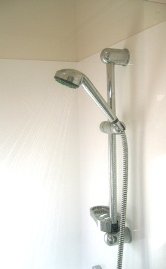Hot Water Heaters
On this page, there are sections on:
Single and Multi Point Hot Water Heaters
There are two distinct types of localized single point heaters.
- Instantaneous
- Storage
The difference between the single point and multi point is:
A single point heater serves only one location, i.e, a sink, a basin etc.
A multi point is generally a boiler that serves more than one draw off point in your home (a draw off point is controlled by a Tap/Faucet).
For example conventional condensing and non-condensing home heating boilers, and condensing and non-condensing combination boilers are multi point water heaters.
However, air hot water heat pumps are unlike conventional boilers see hot water heat pumps below for more information.
The instantaneous single point hot water heater can be fueled by gas or electricity and heat the water only when it is required. These are usually fitted with a swivel spout and located directly above a sink or wash basin. The gas fired heater heats up the water twice as fast as the electric heater and costs less to run.
With the electric instantaneous hot water heater the temperature of the hot water is directly related to the kilowatt (kW) rating of that appliance and the water flow rate. If the water flow too quickly through the electric heater, the heater will not have enough time to fully heat the water. A slower flow rate with this type of heater means hotter water. The same principle applies to instantaneous electric shower heaters.
The storage type of single point hot water heater can be located either above or below a sink. The storage capacity of these units does not exceed 15 litres. The water in these storage heaters is heated by an electric element or an immersion heater to about 60°C.
You should know that it is normal for this type of water heater to drip from the spout. This is because when it heats up the water, the expanding water drips out the spout. A special thermal fitting tap/faucet is usually fitted to allow water to flow through the heater and expand.
Don't worry - the discharge of hot water is limited and it will soon cool. The water in the heater will be hot enough for small rinses.
There are some single point water heaters that incorporate a small expansion vessel where an outlet control valve is used to eliminate dripping.
Combined Gas Storage heaters are hot water cylinders with a gas boiler/heater housed in the center of the storage cylinder, the cylinder is in fact like a water jacket around the heater, and they come as a 'room sealed' appliance.
(room sealed appliances means oxygen is drawn from outside, and the spent combustion gas is also expelled outside through a coaxial flue - the oxygen and spent gas is not taken from or released inside your home)
Hot Water Heat Pumps
The air source heat pump hot water systems are unlike conventional and instantaneous boilers that use fuel like gas or oil to heat water for both domestic hot water and central heating. However, hot water heat pumps are multi point storage water-heaters.
Hot water heat pumps like all heat pumps are designed to take heat from one place and move to another at higher temperatures. An air source stand-alone heat pump water heater takes heat from the surrounding air, increases that heat and then dumps it into a cylinder/tank to heat water.
This type of water heater works in temperatures ranging from approximately 4.5 to 32°C. However, these systems are more efficient in warmer climates as they can then extract more heat from the surrounding air. An efficient hot water heat pump can reduce fuel costs by around 50% compared to other electric water heaters.
If you linked from and want to return to hydronic central heating click here - or to go back to solar heating click here
Ground Source Heat Pumps
Ground and water source heat pumps can be used for hot water storage heating, both are multi point. However, as they are low temperature systems you will have to augment the heat in the storage cylinder/tank, with an electric immersion heater, up to at least 55°C for the prevention against legionella. An electric immersion heater powered by solar energy makes these systems completely environmentally clean and green.
Solar Heating
A solar heating system with efficient 'solar collectors' and matching system components can save you approximately 50 - 60% of your annual energy demands for domestic hot water (DHW), this is also a multi point water heater.
Go to the solar heating page.
Thermostatic Mixing Valves (TMV's)
Thermostatic mixing valves should be fitted to hot water systems to prevent domestic hot water scalding. The young and old are more at risk because their skin is thinner and less tolerant to high water temperatures.
Recommended maximum outlet temperatures for domestic hot water:
- 46°C for baths - Note: This is not a safe bathing temperature
- 41°C for showers
- 41°C for washbasins
- 37°C for bidets
Temperatures should never exceed 46°C when using thermostatic mixing valves.
Adults - It takes 1 second to obtain a full thickness burn with 65°C hot water. It takes 22 seconds to obtain a full thickness burn with 55°C hot water.
Children - It takes 0.5 seconds for a full thickness burn with 65°C hot water. And takes 10 seconds for a full thickness burn with 55°C hot water.
Preventing Legionella
The legionella bacteria can cause serious illness in people, and the reason for storing and distributing water at high temperatures is to prevent the proliferation of the bacteria. The legionella bacteria will multiply at temperatures between 32°C and 41°C.
The legionella will be progressively killed at temperatures above 46°C, at temperatures around 50°C the bacteria will be killed within hours, and at temperatures of around 60°C the bacteria will be killed in minutes. Cold stored water should be below 20°C.
Legionella cannot be contracted by ingesting water, e.g, as in drinking. Legionella can only be contracted through inhalation, e.g, breathing in steam - small water vapours and micro-droplets of water.
An effective way of eliminating the risk of contracting legionella is to store and distribute water at high temperatures and have thermostatic mixing valves (TMV's) near to the points of outlet to ensure bathroom appliances have temperatures between 37°C and 46°C from the outlets.
See also:
Click here to visit online store.
Home Heat Loss Heat Gain Radiant Heat Central Heating Radiators UFH
Heat Pumps GSHP's WSHP's ASHP's Solar Heating PV Systems Boilers
Water Heaters Insulation Elec-Heaters
Terms of Use | Privacy | Contact Us

|
Visitors Say
Hi, My name is Shannon and I'm one of home-heating-systems-and-solutions.com readers. I'd like to thank you for the excellent information I've found on home-heating-systems-and-solutions.com, it's one of my favorite readings on the net. Warmest Regards Shannon United States
Thanks for the advice for removing an air lock from an indirect system. Had to change an inlet on my cistern. First time I have tried any home plumbing. After draining the cold tank system air locked when I refilled the tank. Garden hose and mains pressure up the tap sorted my problems. Would not have known what to do without the advice on the site. Many thanks Sean United Kingdom.
An excellent site. I have found it very usefull. I am currently in the design phase of a new house and have be pondering which heat system to use. From your site I have been able to choose the right system. Ross New Zealand
I enjoyed your site. Pat United States
We're so excited to announce our first Children Book
The Special and Talented Dog Show
To order click here
The second book published is called
Flying Things
This is aimed at a pre-school audience and is a rhyming story. You can buy by clicking here
To read more about our children's books, click here





